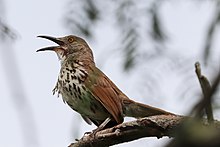Mimid
| Mimids | |
|---|---|

| |
| Long-billed thrasher Toxostoma longirostre | |
| Scientific classification | |
| Domain: | Eukaryota |
| Kingdom: | Animalia |
| Phylum: | Chordata |
| Class: | Aves |
| Order: | Passeriformes |
| Superfamily: | Muscicapoidea |
| Family: | Mimidae Bonaparte , 1853
|
| Genera | |
|
| |
The mimids are the
Description
There are over 30
They have long, strong legs (for passerines) with which many species hop through undergrowth searching for arthropods and fruits to eat. Their habitat varies from forest undergrowth to scrub, high-altitude grasslands, and deserts. The two tremblers live in the atypical habitat of rainforests in the Lesser Antilles, and the brown trembler has the particularly atypical behavior of foraging while clinging to tree trunks.[3]
All known species build somewhat messy, bulky twig nests in dense growth, which are in most species on the ground or no more than 2 meters up. They usually lay 2 to 5 eggs that hatch in 12 or 13 days, which is also the length of time the chicks stay in the nest. Breeding usually starts in the spring or early in the rainy season, and many species can have two or even three broods per year. Most failures to fledge young are due to predation. Pairs often stay together for more than one breeding season.[3]
In the history of science
This section needs expansion. You can help by adding to it. (June 2008) |
Contrary to often-held belief, the
Systematics
Outside the family
They are sometimes united with the starlings in the Sturnidae as a
Within the family
The mockingbirds with some thrashers seem to form one major
For detailed information on the evolutionary relationships of the different mimid lineages, see their articles.
- Genus Mimus – typical mockingbirds (some 10 species, includes Mimodes)
- The former genus Nesomimus, now part of Mimus[10] – mockingbirds of the Galápagos Islands(4 species)
- Genus Melanotis – blue mockingbirds (2 species)
- Genus Dumetella– grey catbird
- Genus Melanoptila– black catbird
- Genus Oreoscoptes– sage thrasher
- Genus Toxostoma – typical thrashers (10 species)
- Genus Ramphocinclus– white-breasted thrasher
- Genus Allenia– scaly-breasted thrasher (formerly in Margarops)
- Genus Margarops– pearly-eyed thrasher
- Genus Cinclocerthia(2 species)
References
- ^ "Mimic Thrush". encyclopedia.com. 2019. Retrieved 9 July 2023. From The Columbia Encyclopedia, sixth ed. (originally published 2000)
- ISBN 1-85391-186-0.
- ^ ISBN 1-55297-777-3
- ^ Curry, Robert L. (2003). Darwin and the mockingbirds of Galápagos. Archived 1 September 2006 at the Wayback Machine
- ^ ISBN 0-300-04969-2
- ^ PMID 16806992(HTML abstract)
- Passerihowever.
- (HTML abstract)
- DOI:10.1642/0004-8038(2001)118[0035:MSABOA]2.0.CO;2 HTML fulltext without images
- ^ American Ornithologists' Union, "Changes since 1 March 2005"
External links
- Mimid videos Archived 12 April 2016 at the Wayback Machine on the Internet Bird Collection
